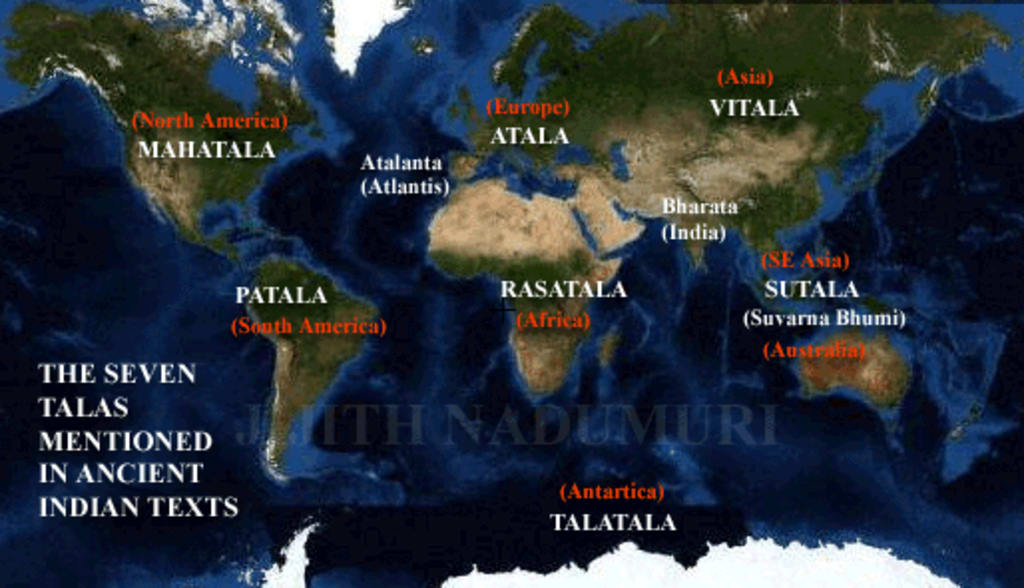“Tracing Ramayana’s Footprints: The Mythic Journey in South America”
Archeological history has steered various transcontinental connections between Indian mythological history- Ramayana and South American history. One such insight is that South America is believed to be the Patal Lok, which is discussed in Hindu mythology.

Patal lok generally means under the sea. It is the bottommost realm in Hindu cosmology!
It begins with the very famous story of the great king Mahabali!
Mahabali was a very generous and benevolent king for his people. He was the grandson of Prahlada! He used to govern his kingdom with absolute devotion and without any discrimination. His people used to treasure his reign over them. He had also possessed the Amrita, which permitted his subjects to bring him back to life once he died in a war. He is immortal, and it is also believed that in the next yuga, King Mahabali will be the king of heaven!
Yuga: In layperson language, it means a time period!
So, the suras (devtas) approached lord Vishnu to save them from this obliteration. Lord Vishnu then incarnated as a Vamana ( a dwarf Brahmin avatar). While Mahabali performed the Ashvamedha sacrifice to commemorate his victories, Vamana approached him and requested about 3 quarters of land. As known, Mahabali was generous; he quickly agreed to proffer Vamana the same! Vamana then metamorphosed into the Trivikrama form, in which his first foot encompassed all of the heavens and his second foot confined all of the Earth. Soon, Mahabali accepted defeat, and he was pushed to Patal Lok.
Now, in one of the podcasts of Nilesh Oak, he clarified that since Mahabali was a very well-loved and respected king for his kingdom, Vamana couldn’t just banish him away or kill him, so King Bali was positioned under house arrest in that region which is somewhat recalled as Indonesia. So Vamana had subdued King Bali, and all his rights were revoked from him. But after the house arrest was halted, King Bali didn’t return to his kingdom. Lord Vishnu offered King Bali to be the next lord Indra if he settled into the Patal lok and performed yagnas. So, Mahabali kept treading further down to Patal Lok. He took precisely the identical path described in Ramayana as the path taken by Sugreeva. Many people from Andhra Pradesh and Kerela migrated there, possibly with Bali .
His journey led him to discover:
SUTALA- islands in Southeast Asia and Australia
TALATALA- Antarctica
PATALA- South America
Bali’s people-based colonies are more in-depth in Mahatal (North America). The inhabitants of these places were known as “Talaraku.” This word was corrupted and became “Toltec.” The Toltec people still live predominantly in Mexico and South America. The Maya (founder of the Mayan calendar) was an engineer who constructed three cities on the island of Bali. That is why Bali was called “tribhuvanak” (lord of the three cities). The word was subsequently altered into Tiahuanaco in Mexico. South Americans believe that someone came from land across the ocean to civilize them whom they referred to as — Viracocha.
There is also a theory that Bali created the Nazca Lines in Peru as markers for airplane docks.
A group known as “Sarpa” drove into Patal at Vamana’s request to scrutinize Bali’s activities. The seven colonies were brand-new, hence their name, “Navatala.”
Tala means colony, and Nava means new.
In South America, the word Navatala still exists in a corrupted form, such as Nahuatl. “Nava” refers to people who live in Mexico and the surrounding areas, and “Nahuatl” is their language expression.
It is stated that Patal Lok is precisely below Earth (then India) and that it is 70000 yojanas farther below the surface of the Earth.
Mexico and Brazil are exactly below India’s surface if contructed a tunnel vertically!
To save Rama and Lakshmana from Mahiranava, Hanuman journeyed to Patal (Brazil) in the Ramayana.
So, these are some of connections that actually shows that Hindu mythology should never be underestimated!





Comments
There are no comments for this story
Be the first to respond and start the conversation.